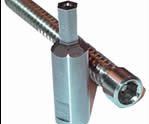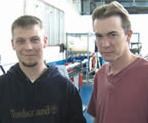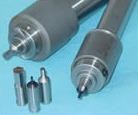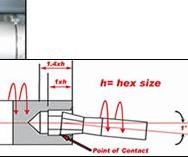Rotary Broaching 101
There continues to be new ways of driving fasteners into the materials they are intended to hold together.
In recent years, there has been a push from the medical industry to use bone screw applications with hex shapes, Torx or Hex lobular and square and spline drives. In doing so, materials such as titanium, cobalt and high-temperature alloys have made the job of putting a shape in the head of a screw much more difficult.
Rotary broaching, also known as wobble broaching, has been one method used to obtain these various shapes. Well known and used for years on automatic lathes, rotary broaching has become the method of choice on Swiss-type machines, CNC lathes and machining centers because it eliminates a secondary operation.
The basic principle of rotary broaching is relatively simple. Internal and external polygonal profiles are single-point shaped rather than form punched. The operation is performed in only a few seconds while the spindle is rotating. Rotary broach manufacturer PCM Willen SA (Villeneuve, Switzerland) reports that the cutting action requires 80 percent less force than form punching when the optimum feed rate is used. The reduced stress increases tool life and lowers machine maintenance cost over time.
On a machining center, the broach holder revolves in the spindle while the tool and part are stationary. This is opposite of how one is positioned on a lathe where the part rotates synchronously with the tool while the holder is held in an endworking position. The operation takes only seconds and can eliminate a secondary operation so the part can be produced completely in one setup.
The broaching holder serves two functions: It holds the broach tool in a free spinning bearing and places it at a 1-degree angle relative to the centerline of the workpiece. The face of the broach tool is the apex of the 1 degree and is located on the same centerline as the workpiece. A 1 1/2-degree clearance angle is built into the tool. As the tool comes into contact with the spinning part, it begins to rotate synchronously like a gear because of friction. As the tool is thrust into the pre-drilled hole, the wobble effect causes the leading edge to rotate in and out of the cut like a cam.
As the tool advances forward in a wobbling motion, each tooth cuts the same groove with a scalloping effect as it rotates in and out of the leading point position. This is similar to a wobbling coin, only one point is touching at any given time, greatly reducing the amount of force needed to form the shape.
The following information includes tips and tutorials on how to broach a hole to quality standards.
Preparing to broach a hole – The hole should first be prepared with a 60-degree to 90-degree chamfer slightly bigger than the largest dimension of the broach tool. This ensures easy starting of the broach by guiding the tool.
Drilling the hole – For internal broaching, the hole should be drilled approximately 1 percent bigger than the diameter across the flats of a hex shape. This percentage can be reduced when free cutting material and increased as machinability decreases. For mild steel, the following tolerances are recommended:
0.059 - 0.118 = 0.001 - 0.002
0.118 - 0.236 = 0.0015 - 0.0035
0.236 - 0.394 = 0.0025 - 0.005
0.394 - 0.630 = 0.004 - 0.008
> 0.630 = 0.006 - 0.012
Drill the hole as deep as possible to leave room for chip accumulation. A depth of 1.3 to 1.5 times the length of the profile is recommended. If the chips need to be removed, re-drill the hole with a slightly smaller drill size.
Drill radius not allowed – Many medical and aerospace applications do not allow for a drill radius along the broached walls of the part. When exact concentricity is required, co-bore, drill and pre-bore the hole, which will keep the broach concentric when it enters the hole.
As the broach plunges into a tight fitting hole, there is no room for air or coolant to escape. The hydraulic pressure being generated is enough force that something must give. Many times, the part or tool will push back, which may cause tool or machine damage. In this case, use of a pressure relief vent in the broach is recommended, allowing oil and air to escape.
Recommended speed – The basic principle of the 1-degree offset allows high speed applications from 1,500 rpm up to 3,000 rpm. Surface footage has little affect on the cutting action or the tool life. The cutting edges of the broach tend to dig into the part face as the tool comes into contact with the rotating material. At higher speeds, this dig mark will become more pronounced and tool life will suffer. For best results, start the broach operation at a slow rotation, and then increase the speed when it is in full contact. Reversing the spindle rotation halfway into the part can reduce spiraling.
Feed rate – The feed choice mainly depends on the material characteristics. In mild steel, 0.0012 to 0.0024 per revolution is recommended. If the machine thrust force is sufficient, the feed can be doubled (even tripled) as machinability increases. In most cases, the maximum feed rate should not exceed 0.03 times the profile diameter. A slower feed rate will produce an improved finish with finer lines along the sidewalls of the broached hole. By increasing the feed rate, the cutting cycle will be faster, but the broaching lines will be more pronounced, leaving a coarse finish.
Coolant – Water-soluble coolant or cutting oil are both sufficient for rotary broaching. The increased size of the pre-drilled hole usually provides ample space for coolant to leak out as the broach tool plunges in. In a tight-fitting hole, a pressure relief vent should be added to the broaching tool.
Centering the broach – To obtain a quality broached hole and to optimize tool life, the tool should be on center with the workpiece within 0.0008 inch or less. Poor centering will result in the shape being eccentric with the bore, as well as spiraling, increased dig marks at the start, oversized holes and reduced tool life.
Centering the broach tool with the workpiece can be achieved in or out of the machine. However, the most accurate way to indicate the tool is to do so on the machine while the tool is in the station that will be used for broaching.
For machines like turret lathes that cannot place the tool accurately with the spindle center line, an adjustable broaching head should be used. With an adjustable head, a gage pin that is the same length as the broach, is inserted into the head and the tip is indicated to find the center.
Adjusting centering off-line – (See Fig. 1) Set the indicator tip (5) on the gage pin (4) at the correct "L." Rotate the holder on its shank (2) in the preset fixture (1) to obtain a maximum TIR of 0.0008 inches. (Notice the oscillation of the gage pin as it rotates with the holder.)
Adjust the position using the four adjusting screws. Upon completion, clamp the head tight with the clamping screws. Check again after clamping.
Adjusting center on the machine – (See Fig. 2) This offers the advantage to correct misalignment between the machine spindle and the turret bore. With the gage pin (4) set to the proper "L," set the broach head in the turret station (1) to be used for broaching. Set the indicator (5) on to the spindle chuck with a magnetic base. Place the indicator tip on to the end of the gage pin. Rotate the chuck so the indicator sweeps the diameter of the pin, and adjust accordingly using the adjusting screws.
Related Content
The Value of Mass Finishing, Shot Blasting for Aerospace and Medical Applications
The choice between mass finishing and shot blasting for CNC-machined parts depends on the specific requirements of the application.
Read MoreThe Control’s Role in Machining Complex Parts
This company that produces medical implants finds value in the CNC for its turn-mill equipment that helps speed setups and simplify programming when producing intricate parts complete.
Read MoreLaser Technology "Turns" into a Turning Tool
This new technology uses a laser to act as a cutting tool to "turn" parts from solid barstock. This high-speed precision turning machine is especially useful for micromachining, enabling high accuracy for small, complex parts that are often delicate and difficult to machine when implementing conventional turning processes.
Read MoreMeeting Stringent Cleaning Goals With Modular Ultrasonic System
A knee implant manufacturer implements an advanced cleaning system that meets its tight cleaning requirements, including documenting, validating and tracing the entire cleaning process.
Read MoreRead Next
Do You Have Single Points of Failure?
Plans need to be in place before a catastrophic event occurs.
Read More5 Aspects of PMTS I Appreciate
The three-day edition of the 2025 Precision Machining Technology Show kicks off at the start of April. I’ll be there, and here are some reasons why.
Read MoreEmerging Leaders Nominations Now Open
Here’s your chance to highlight a young person in your manufacturing business who is on the path to be a future leader moving your company forward.
Read More


















.jpg;maxWidth=300;quality=90)








